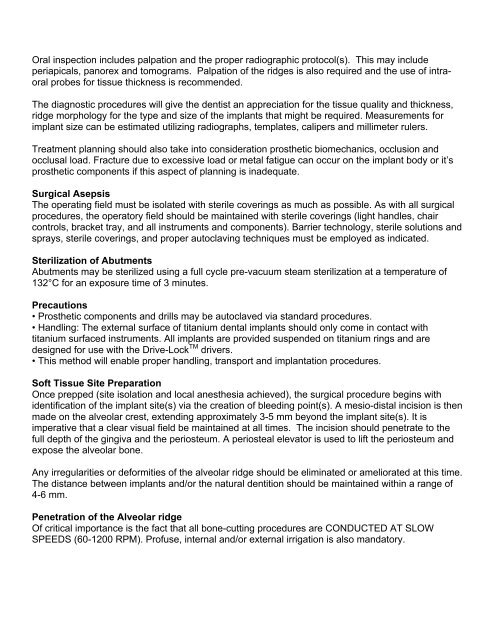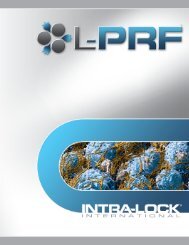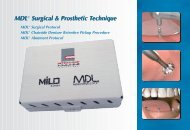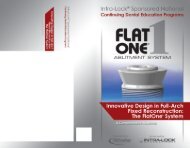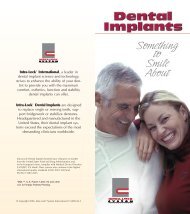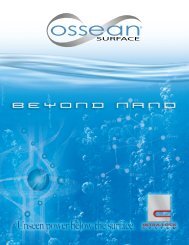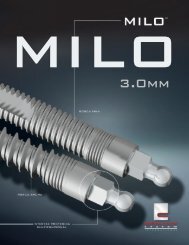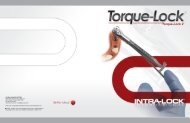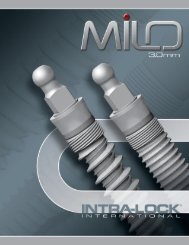Dental Implant Instructions For Use Indications Intra-Lock® Implants ...
Dental Implant Instructions For Use Indications Intra-Lock® Implants ...
Dental Implant Instructions For Use Indications Intra-Lock® Implants ...
Create successful ePaper yourself
Turn your PDF publications into a flip-book with our unique Google optimized e-Paper software.
Oral inspection includes palpation and the proper radiographic protocol(s). This may include<br />
periapicals, panorex and tomograms. Palpation of the ridges is also required and the use of intraoral<br />
probes for tissue thickness is recommended.<br />
The diagnostic procedures will give the dentist an appreciation for the tissue quality and thickness,<br />
ridge morphology for the type and size of the implants that might be required. Measurements for<br />
implant size can be estimated utilizing radiographs, templates, calipers and millimeter rulers.<br />
Treatment planning should also take into consideration prosthetic biomechanics, occlusion and<br />
occlusal load. Fracture due to excessive load or metal fatigue can occur on the implant body or it’s<br />
prosthetic components if this aspect of planning is inadequate.<br />
Surgical Asepsis<br />
The operating field must be isolated with sterile coverings as much as possible. As with all surgical<br />
procedures, the operatory field should be maintained with sterile coverings (light handles, chair<br />
controls, bracket tray, and all instruments and components). Barrier technology, sterile solutions and<br />
sprays, sterile coverings, and proper autoclaving techniques must be employed as indicated.<br />
Sterilization of Abutments<br />
Abutments may be sterilized using a full cycle pre-vacuum steam sterilization at a temperature of<br />
132°C for an exposure time of 3 minutes.<br />
Precautions<br />
• Prosthetic components and drills may be autoclaved via standard procedures.<br />
• Handling: The external surface of titanium dental implants should only come in contact with<br />
titanium surfaced instruments. All implants are provided suspended on titanium rings and are<br />
designed for use with the Drive-Lock TM drivers.<br />
• This method will enable proper handling, transport and implantation procedures.<br />
Soft Tissue Site Preparation<br />
Once prepped (site isolation and local anesthesia achieved), the surgical procedure begins with<br />
identification of the implant site(s) via the creation of bleeding point(s). A mesio-distal incision is then<br />
made on the alveolar crest, extending approximately 3-5 mm beyond the implant site(s). It is<br />
imperative that a clear visual field be maintained at all times. The incision should penetrate to the<br />
full depth of the gingiva and the periosteum. A periosteal elevator is used to lift the periosteum and<br />
expose the alveolar bone.<br />
Any irregularities or deformities of the alveolar ridge should be eliminated or ameliorated at this time.<br />
The distance between implants and/or the natural dentition should be maintained within a range of<br />
4-6 mm.<br />
Penetration of the Alveolar ridge<br />
Of critical importance is the fact that all bone-cutting procedures are CONDUCTED AT SLOW<br />
SPEEDS (60-1200 RPM). Profuse, internal and/or external irrigation is also mandatory.


